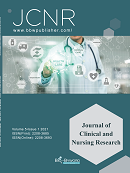The Contribution of Health Education to the Falling Incidence within Hospital Premises in China
Abstract
Abstract: Falling is the second leading cause of accidental injury to death worldwide. It is estimated that more than 80% of the people die each year in low and middle-income countries. Falling is also the leading cause of death among the elderly in China. Among them, the falling rate in 2016 increased by 5% compared with 2006. Although not fatal, those who fell and have a disability, which may face significant economic risks associated with subsequent long-term care needs, especially for the elderly [1]. It may be essential to use evidence-based guidelines for proving health education to address the issue of preventing hospitalization for the elderly. This article will combine the author’s practical experience to examine the contribution of health education to prevent falls and explore its application and development in China. Lastly, it will explain barriers to health education.
References
Boyé N, Van L, Esther MM, et al., 2013, The Impact of Falls in the Elderly. Trauma, 15(1): 29–35.
Smith ML, Towne SD, Motlagh AS, et al., 2017, Programs and Place: Risk and Asset Mapping for Fall Prevention. Frontiers in Public Health, 5:28.
Nelson-Wong E, Appell R, McKay M, et al., 2012. Increased Fall Risk is Associated with Elevated Co-Contraction about the Ankle During Static Balance Challenges in Older Adults. European Journal of Applied Physiology, 112(4):1379–1389.
Zhang L, Dalal K, Yin M, et al., 2012, The KAP Evaluation of Intervention on Fall-Induced Injuries among Elders in a Safe Community in Shanghai, China. PLoS ONE, 7(3):96–105.
Whitehead D, 2008, An International Delphi Study Examining Health Promotion and Health Education in Nursing Practice, Education and Policy. Journal of Clinical Nursing, 17(7): 891–900.
Scott V, Gallagher E, Higginson A, et al., 2011, Evaluation of an Evidence-Based Education Program for Health Professionals: The Canadian Falls Prevention Curriculum© (CFPC). Journal of Safety Research, 42(6):501–507.
National Institute for Health and Care Excellence, 2013, Falls in Older People Assessing Risk and Prevention. https://www.nice.org.uk/guidance/cg161/resources/ pdf-35109686728645
General Office of the State Council of the People’s Republic of China , 2016, Healthy China 2030 Planning Outline. http://www.gov.cn/zhengce/2016-10/25/content_5124174.htm>
Parrish DE, 2018, Evidence-Based Practice: A Common Definition Matters. Journal of Social Work Education, 54(3):407–411.
Mullen EJ, 2016, Reconsidering the Idea of Evidence in Evidence-Based Policy and Practice. European Journal of Social Work, 19(3-4):310–335.
Dilley L, Gray S, Zecevic A, et al., 2014, An Educational Video to Promote Multi-Factorial Approaches for Fall and Injury Prevention in Long-Term Care Facilities. BMC Medical Education, 14(1):102.
Ma Q, Chan AHS, Chen K. 2016, Personal and Other Factors Affecting Acceptance of Smartphone Technology by Older Chinese Adults. Applied Ergonomics, 54:62–71.
Lin S, Tseng WT, Hsu M, et al., 2017, A Psychometric Evaluation of the Chinese Version of the Nursing Home Survey on Patient Safety Culture. Journal of Clinical Nursing, 26(23-24): 4664–4674.
Wan YA, Neni H, Siew TL, et al., 2018, Evaluation of a Fall Prevention Educational Video on Fall Risk Awareness, Knowledge and Help Seeking Behaviour Among Surgical Patients, Singapore Nursing Journal, 45(1):27–33.
Kang YO, Song R, 2018, Effects of Fall Prevention Education Program on Attitudes, Prevention Behaviors, and Satisfaction among Elderly Inpatients. Korean Journal of Adult Nursing, 30(1):49-59.
Zhu Y, Ghajar M, Mitre E, 2016, SHARE: Spreading Health Awareness with Resources and Education-Librarians’ Role in Patient Education, A Case Study. Journal of Hospital Librarianship, 16(4):319–327.
Klingbeil C, Gibson C, 2018, The Teach Back Project: A System-wide Evidence Based Practice Implementation. Journal of Pediatric Nursing, 42:81–85.
Mackay M, Joyce-Mccoach J, Stephens M, et al., 2016, Review of Transnational Nursing Education Programme Curricula: Process, Findings, and Recommendations. Nurse Education Today, 42:73-77.
Cerilo PC, 2016, Effectiveness of Fall Prevention Multimedia Program on Patient Awareness, Self-Efficacy, and Engagement, Effectiveness of Fall Prevention Multimedia Program on Patient Awareness, Self-Efficacy & Engagement, p.1.
Wang X, Chontawan R, Nantsupawat R, 2012, Transformational Leadership: Effect on the Job Satisfaction of Registered Nurses in a Hospital in China. (Report). Journal of Advanced Nursing, 68(2):444–451.
Zhang H, Shen Q, 2014, The Current Situation of Rehabilitation Medical Service System in China: Problems and Challenges. Business and Management Research, 3(2):42-46.
Anderson J, Browne A, Reimer-Kirkham S, et al., 2010, Uptake of Critical Knowledge in Nursing Practice: Lessons Learned from a Knowledge Translation Study. Canadian Journal of Nursing Research, 42(3):106–122.
Lee H, Chang K, Tsauo J, et al., 2013, Effects of a Multifactorial Fall Prevention Program on Fall Incidence and Physical Function in Community-Dwelling Older Adults With Risk of Falls. Archives of Physical Medicine and Rehabilitation 94(4):606-15.
Sonnad SS, Mascioli S, Cunningham J, et al., 2014, Do Patients Accurately Perceive Their Fall Risk?, Nursing, 44(11):58–62.
Wu B, Darina VP, Jing W, et al., 2019, Dementia Caregiver Interventions in Chinese People: A Systematic Review. Journal of Advanced Nursing 75(3):528-542.
Driscoll J, Stacey G, Harrison-Dening K, et al., 2019, Enhancing the Quality of Clinical Supervision in Nursing Practice. Nursing Standard, 34(5):43–50.
Xia Q, Jiang Y, Niu CJ, et al., 2009, Effectiveness of a Community-Based Multifaceted Fall-Prevention Intervention in Active and Independent Older Chinese Adults. Injury Prevention, 15(4):248–24851.
You LM, Liu K, He G, et al., 2013, Hospital Nursing, Care Quality, and Patient Satisfaction: Cross-Sectional Surveys of Nurses and Patients in Hospitals in China and Europe. International Journal of Nursing Studies, 50(2):154–161.
Luk JK, Chan TY, Chan D, 2015, Falls Prevention in the Elderly: Translating Evidence into Practice. Hong Kong Medical Journal of Xianggang Yi Xue Za Zhi, 21(2):165-171.
Gallant M, Tartaglia M, Hardman S, Burke K, 2019, Using Tai Chi to Reduce Fall Risk Factors Among Older Adults: An Evaluation of a Community-Based Implementation. Journal of Applied Gerontology, 38(7):983-998.
Hu YN, Chung YJ, Yu HK, et al., 2016, Effect of Tai Chi Exercise on Fall Prevention in Older Adults: Systematic Review and Meta-analysis of Randomized Controlled Trials. International Journal of Gerontology 10(3):131-36.
Wang L, Ning P, Peng Y, et al., 2019, Unintentional Falls Mortality in China, 2006-2016. Journal of Global Health, 9(1):010603.
Zhang F, Tian L, Shang X, Li, X., et al., 2018, Exploring Relationships Between First-Line Nurse Manager’s Safety Attitudes and Safety Factors in Henan, China. Journal of Nursing Management, 26(3), 14–320.


